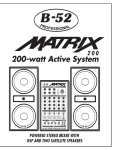Download Brutus 170W
Transcript
USER MANUAL AX ELEKTRONIKA d.o.o. BRUTUS 170W / S stereo power amplifier BRUTUS - 170W/S is stronger brother of the popular BRUTUS - 100W/S power amplifier. BRUTUS - 170W/S is operating in the bridge configuration, which ensures such a high output. Thanks to IC TDA7294 manufactured by SGS Thompson (www.st.com) that you can buy for few Euros you can make a compact 170W power amplifier. It’s PCB measures just 5,5 x 21 cm. TDA7294 is housed in Multiwatt 15 package and is intended for audio power amplifiers operating in class AB. It’s usable in wide area of applications, from Home Cinema speaker systems to active speakers, high-end TV sets and of course home brew amplifier projects. Due to it’s large power supply voltage range is this IC capable of delivering large power to 4, 8 and 16 Ohms speakers. TDA7294 has 100W output power at RL = 8 Ohms; VS = ± 38V, and 100W at RL = 4 Ohms; VS = ± 29V. THD is lower than 0,1% at PO = 0.1 to 50W and f = 20Hz to 20kHz. Detailed information on power output and THD can be seen in diagrams. Let us firstly list basic data about TDA7249 in table 1. Special attention should be paid for the max. power supply voltage which should not ex- ceed ± 49V. In case that voltage exceeds ± 49V your TDA7294 will silently burn out. In the amplifier circuit are four pieces of TDA7294. It means that we might find out that all four ICs are dead as Dodo! Take a look also at table 2, where technical data for TDA7294 are listed. Another important issue is speaker impedance. Speaker should have min. 8 Ohms impedance. Just for illustration, with Vss of just ± 25V and 8 Ohms speakers output power reaches 150W, while at Vss = ± 35V and 16 Ohms speaker we can reach output power of respectable 170W! You may ask yourself what can happen if instead of 8 Ohms speakers 4 Ohms ones are used? Well, not much if TDA7294 is concerned. Amplifier will deliver max. output power to 4 Ohms speakers limited time until ICs overheat. Due to IC’s thermal protection circuitry TDA7294 will automatically reduce output power to safe value. Schematic diagram of the BRUTUS - 170W/S power amplifier can be seen at fig. 2 Table 2: Electrical characteristics DMOS 170W schematic Table 1: Absolute maximum ratings 1 As mentioned earlier, BRUTUS 170W/S is configured in the bridge configuiration. One of it’s advantages is that there is no output capacitor which improves frequency response of amplifier. With the switch S1 MUTE or PLAY mode are selected. Let us now take a look at IC itself. TDA7294 has 4 main parts: MUTE circuitry with Stand-by function, preamplifier circuitry, power output stage and short protection circuitry. TDA7294 has builtin protection from the short circuit on the out- put terminals. It has also thermal protection which turns off output stage, when silicon die reaches 145°C. Power supply is blocked with 100nF capacitors near ICs. Together with 2.200 µF filter capacitors ensures a clean power supply voltage for IC. Let us emphasize that 2.200 µF capacitors that are placed near IC are here purely to improve 100 Hz filtering while main filtering must be done with 10.000 µF capacitors that are located on power supply PCB. Resistors R2 and R3 (R12 and R15 respectively) set the amplification of the circuit. With values that you see in the schematic diagram amplification is set to 30 dB. Capacitor C9 sets the low frequency cutoff therefore lowering value of C9 should be done carefully. If you lower capacitance of C9 the low frequency cut-off will be higher which means that lower tones will be attenuated. Lowering capacitance of decoupling capacitor C3 will cause same effect as changing value of C9. Input resistance is set with R1, which should be same as R2. Electrical schematic of BRUTUS 170W/S is a bit different from the original application note. Difference is at the MUTE and STAND-BY pins, that are connected to one switch S1. To reach max. attenuation MUTE switch S1 should be connected to GND, while for normal operation it should be connected to +Vcc. Power supply Power supply of this amplifier is simple. You should use centre-tapped transformer with 2x27V AC Figures 3: Output Power vs. Supply Voltage. Table 3: The recommended values of the external components (reffers to original application note at fig. 1) Figures 3: Distortion vs. Output Power Figure 1: Typical application circuit 2 outputs. Transformer should be rated at 500W min. if you want to achieve full 170W stereo output power from all ICs. Use suitable bridge rectifier rated at 35A min. We suggest to use a rectifier which can be easily screwed to amplifier enclosure. At power supply PCB you should use 4 pcs. of 10.000 µF capacitors however, you can use only 2 pcs. of 10.000 µF if hum is at acceptable level. 100nF capacitors are added to reduce high frequency noice. Note that power supply has separate PCB and is not included on the BRUTUS - 170W/S PCB! To prevent too high inrush current at powering up torodial transfor- Figures 5: Diagram of MUTE function mer we recommend to make s simple circuit as indicated in the schematic diagram (figure 2). The circuit consists of resistor RS and switch S2. Resistor should have 390 Ohms/ 2W. At powering up the amplifier resistor limits inrush current to a safe value. Few seconds after turning power on you can close switch S2 which will enable normal operation of amplifier. All of you that are good in electronics will probably make a time relay, which will automatically after few seconds short resistor RS. In case that you do not wish to use this simple protective circuit you will probably change fuses quite often. On Fig. 6 you can see schematics of simple time delay circuit. This circuit can be built on prototype veroboard. In the circuit the BS170 N-type MOSFET transistor is used. To it’s Gate the capacitor Cs is connected. Cs together with Rs makes an RC circuit, which determines time delay, at which transistor T1 will turn on relay. Resistor Rp determines discharge time of Cs. This resistor is here because Cs cannot discharge itself through MOSFET due to high input resistance of Gate terminal. If Cs would not discharge, T1 would remain open also when we turn off power supply, which would mean that at next powering up the RS will be shorted and will not function as a protection for your transformer. Zenner diode D1 is needed to drop supply voltage to a safe value. Instead of zenner dio- Fig. 2: Schematic of the BRUTUS - 170W/S power amplifier 3 RS Building Power amplifier KIT Figure 6: Time delay circuit Table 4: Table of components for BRUTUS - 170W/S stereo amplifier with TDA7294 P.C.B. and Components layout 4 de you can use 12V regulator like 7812. Power supply of time delay circuit is connected to 27V AC and GND as seen in the schematic diagram. LED is added to signalize power supply voltage. Building power amplifier is easy. Firstly solder all resistors, diodes and ceramic capacitors. Then solder small electrolytic capacitors, connectors, sockets and finaly 2.200 µF capacitors. If you feel more confortable you may firstly screw all TDA7294 to suitable heatsink and the solder them to the PCB. At mounting TDA7294 to heatsink note that you should use suitable mica washers to isolate ICs from the potential of the enclosure – which is normaly connected to GND. Tabs of TDA7294 are connected to –Vss so you should be careful when mounting them to heatsink. Screws should be insulated with insulating bushes. Between mica washer and TDA7294 you should apply silicone heatsink compound which improves thermal conductivity between TDA7294 and heatsink. Suitable mica washers and insulating bushes are included in the KIT set. When screws are screwed (do not screw them too much – you might damage TDA7294!!) you should check resistance between TDA7294 tab and heatsink with continuity check with your measuring instrument. If there is no connection you may mount heatsink to your enclosure. Before you connect power supply to your amplifier make sure that input potentiometers (P1 and P2) are connected to GND i.e. input signal is set at minimum. We have got reports from customers that when they turned on power supply, amplifier delivered max. output power to loudspeakers which caused damage of loudspeakers. When you turn on power supply with volume set to minimum you will not hear a thing – also due to automatic elimination of pop and click at power on. TDA7294 has very minor noise, so do not be surprised if nothing will be heard. Also do not forget to turn MUTE/PLAY switch to PLAY position. Connect input signal to J11&J12 (J13&J14 respectively). Slowly turn on volume and now you could enjoy sound of your BRUTUS - 170W/S amplifier.












